SEDIMENTARY AND METAMORPHIC ROCKS AND AGE DETERMINATION
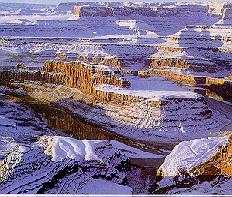
The photo shows
rock layering or stratification which is a typical feature associated with
sedimentary rocks--natural gas and petroleum are formed and found in
sedimentary rocks--fossils which occur in sedimentary rocks show the life forms
present on Earth during geologic time
I. Sedimentary rock
family
A. Definition and explanation
- are rocks comprised of
sediments accumulated from physical or chemical processes and consolidated
through lithification---the accumulation of
sediments occurs primarily in ocean waters or other large bodies of water,
after which the sediments lithify or
change into solid rocks
B. Some important factors and concepts related to the
formation of sedimentary rocks
1. Weathering
·
is the "breaking down" of rock materials at or
near the surface of the Earth
o
chemical weathering is the decomposition of materials
resulting in the formation of new minerals or materials--new materials form
through removal of or additions to the weather substance
o
physical or mechanical weathering is the disintegration of
materials in which no new minerals or substances are formed
·
both chemical and physical weathering processes can affect a
rock material to contribute to the overall breakdown
2. Erosion
·
is the removal or transportation of materials by stream
water, glacial ice, wind, and gravity---these materials eventually may become
deposited in large amounts
3. Lithification
·
is the process(es) by which
accumulated sediments become rock material---compaction of sediments by its own
weight and cementation of the particles by a natural gluing agents carried
through the sediments are two important lithification
processes
·
is the occurrence of sedimentary rocks in layers (strata or
beds) and can be considered the most common feature related to all sedimentary
rocks---it is easily seen why sediments depositing in a medium would form in
layers
·
click here to see stratified
layers in the Grand Canyon, Arizona
5. Law of superposition
·
states that during
the formation of sedimentary rocks, each layer is older than the one above and
younger than the one below---this statement reflects the relative age of
sedimentary rocks.
C. Sedimentary rock types
- there are three types of
sedimentary rocks based on the way they form; clastic (detrital), chemical
(inorganic) and organic(biological)---a rock table summarizing the
descriptions of these rock types will be given below
1. Detrital or clastic rocks
·
are rocks formed from the accumulation of sediments by
primarily physical or mechanical processes---sediments are formed from the
erosion of preexisting rock materials and deposited by agents such as stream
water, wind, glacial ice, and gravity mainly into large bodies of water,
although some sediments and sedimentary rocks can form at the surface---these
sediments then become rocks through lithification
·
detrital sediment
classification (Wentworth's particle size) is based on the size of the
sedimentary particle---the largest size called a boulder, the smallest called
clay.
·
click here to see the sedimentary
particle sizes
·
Kinds of clastic rocks---based primarily on sediment (particle)
size
o
conglomerate (comprised of large rounded particles), breccia
(comprised of large sharp-edged shaped particles), graywacke
sandstone (comprised of dark sand sized particles), arkose
sandstone ( sand sized particles with alot of
feldspar especially orthoclase), quartz sandstone ( sand sized particles
comprised largely of quartz particles), siltstone (a fine grained rock with a
gritty feel), claystone (a very fine grained rock
which feels slick when wet), shale ( a very fine grained rock which is fissile
or breaks into sheets)
o
siltstone and claystone can be
undifferentiated and called mudstone
2. Organic or biological rocks
·
are rocks formed from the accumulation of animal shells or
plant materials and lithified---size of sedimentary
particle is not important in naming the rock
·
Kinds of organic rocks
o
limestones (effervesce
(bubble) with addition of dilute acid)
§
fossiliferous
limestone--animal shells in an opaque mud
§
coquina--comprised essentially of 100% seeable animal shells
§
chalk--comprised essentially of 100% invisible animal
shells--can be scratched with the fingernail---the White Cliffs of Dover in
England is an example of a large chalk deposit
§
click here to see the
"White Cliffs Of Dover" or see
page 158 in text
o
coal
§
the coal series explains the sequence of changes of buried
plant materials to coal---the series is as follows: buried plants--to--peat
(recognizable non-fossilized remains of plants)--to--lignite (a crude burning
material)--to--bituminous coal—see page
161 in text
o
chert
§
is a rock consisting of very tiny (micro) animal shells and
comprised of silica (quartz-like material)
3. Chemical rocks
·
sediments formed from chemical precipitation, accumulation
and lithification---size of sedimentary particle is
not important in the naming of the rock
·
evaporites--rocks
formed from the evaporation of ocean or fresh water in which solubilized
substances become supersaturated and precipitate forming deposits---rock gypsum
(softer than a fingernail) and rock salt are examples of evaporite
rocks---the Great Salt Lake in Utah and the Dead Sea are examples of bodies of
water which have produced and are producing evaporite
rocks
·
click here to see evaporite rock halite rocks in Death Valley, California
or see page 160 in text
·
limestones
o
non-bioclastic fossiliferous
limestones, crystalline limestones,
micrite (very fined grained), and oolite
(comprised of small spherical particles)
·
dolostone--rock
dolomite
·
chert (flint)--often
found in layers or in pods within other sedimentary rocks as limestones
click here to see
sedimentary rock table(1) which includes rocks discussed above
D. Some special features in sedimentary rocks
1. cross-bedding
·
relatively thin layers inclined at an angle to the main
bedding
·
formed by currents in water or wind
·
click here to see cross bedding
or see page 167 in text
2. graded
bedding---see bottom of page167 in text
·
a sediment layer characterized by a decrease in sediment
size from bottom to top
3. ripple marks---see page
168 in text
·
small waves of sand that develop on surface of sedimentary
layer by the action of moving water or air
·
click here to see ripple marks
E. Significance of sedimentary rocks
1. The only family of rock
containing an abundant record of life forms and the changes of life forms
throughout geologic time
2. The only family of rock in which
natural gas, petroleum, coal uranium and salt form and from which these are
extracted in abundance
3. Used for constructing buildings,
tomb stones, and some limestones are used as drive
way coverings and an important source of lime
Click below for important references for the sedimentary
rock family
– see page 196 in text for many of the
uses and importances’ of sedimentary rocks
II. Metamorphic rock family
A. Definition and explanation
- rocks formed primarily
through the action of heat and/or pressure on preexisting rocks in which
there is essentially no melting during the process---time is also a factor
in the metamorphic process
- rocks will lose any evidence
of fossil remains and other features that were present before the
metamorphic change
B. Types of metamorphism
1. Contact or thermal
·
small igneous magma bodies as stocks intrude country rock
"baking" the rock---this metamorphism or change of preexisting rock
is caused primarily by temperature effects associated with the intruding
magma---low grade of metamorphism likely because of lower
temperature associated with the metamorphism
2. Regional
·
larger igneous magma bodies as batholiths or laccoliths
intrude country rock and form a much greater area of metamorphism---temperature
and pressure are equally important as agents in this kind of
metamorphism---high grade of metamorphism likely because of higher temperatures
associated with the metamorphism
- all but one kind
(marble) of metamorphic rock are comprised of silicate minerals---a rock
table outlining the types of rocks discussed below will be given later
1. Foliated metamorphic rocks
·
minerals are aligned in a pattern
o
gneiss--visible minerals appear in straight parallel or
nearly parallel bands---most gneisses resemble phaneritic
textured rocks like granite because they often form from these rocks
o
schist--visible minerals appear in irregular or wavy bands
and often contain much mica (biotite and/or
muscovite)---the parent rock is usually shale
o
slate--invisible minerals are aligned and the rock appears
to have a "rock cleavage" breaking along layers---the parent rock is
usually shale
o
phyllite--visible
but small minerals are aligned and the rock looks like a hybrid or cross
between a schist and a slate---the parent rock is usually shale
2. Non foliated metamorphic rocks
·
minerals are not aligned in a pattern but occur arranged
"at random" in the rock
o
marble--comprised of CaCO3 and form from limestone or dolostone
o
quartzite--comprised of silicate minerals and formed from
sandstone
o
metaconglomerate--comprised
of large mineral fragments and form from conglomerate
o
amphibolite--comprised of seeable minerals and usually forms
from a basalt---this rock looks like a gabbro
o
anthracite coal--a high grade of coal formed from bituminous
coal
o
click here to review metamorphic
rocks defined above and see the metamorphic rock table(2)
D. Important uses
1. Used as building materials, and
tombstones
2. Marble can be used in art as a
sculpturing material
click below for
more information on metamorphic rocks
III. Age determination (geologic age)
- now that we have studied
the principles of the 3 rock families in detail including the crosscutting
and intrusive-extrusive nature of igneous rocks and the law of superposition
pertaining to sedimentary rocks, and the absolute age determination method
in the mineral section, the basic concept of age determination should be
easy for you to comprehend---follow the interpretation of geologic events
in page click here to see relative
age events
B. Age determination method---see
pages 448-453 in text
- relative and absolute
age determination methods are used together to establish absolute age of
rocks which cannot themselves be dated using the absolute age
determination method--as mentioned in the mineral section igneous rocks
are the best to determine absolute age dates
- click
here to see figure 1 and the relative and absolute age methods used
together
- in figure 1 determine
the absolute age date of formation B: A is older than B which is older
than C (from the law of superposition)--igneous intrusive, V was dated at
2.15 million years--lava flow, P was dated at 2.25 million years (both V
and P were dated using an absolute age determination method)--since V
bakes (metamorphoses) B, B is older than intrusive V ( B is greater than
2.15 million years)--since lava flow P does not bake (metamorphose) B, B
is younger than P (B is less than 2.25 million years)--therefore B is
between 2.15 and 2.25 million years old
- Index fossils are also
important in the age dating of rocks. Once a species of fossil is
identified as being of a specific age, other sedimentary rocks long
distances away and having that same species must be of the same age. -- see pages 248-249 in text
click
here to read more about relative and absolute age determinations
page 135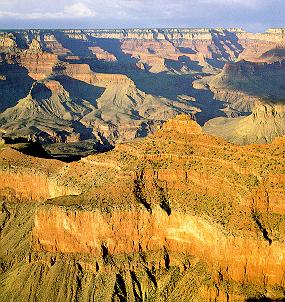 click to return
click to return
page 133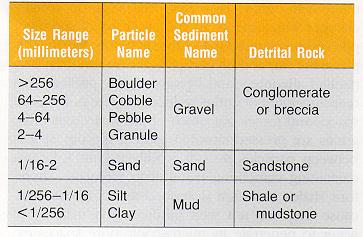 click to return
click to return
page 138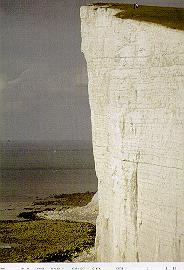 click to return
click to return
page 141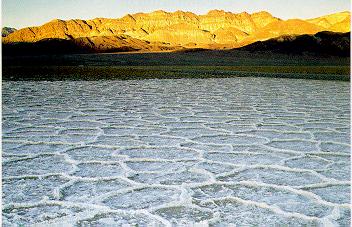 click to return
click to return
table 1 click to return
click to return
table 2 click to return
click to return
table 2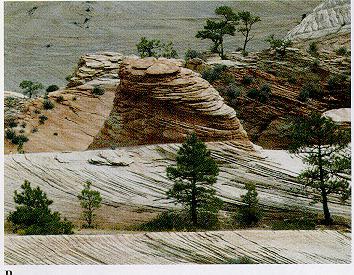 click to return
click to return
table 2 click to return
click to return
page 179 click to return
click to return
figure 1 click to return
click to return